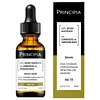What's inside
What's inside
 Key Ingredients
Key Ingredients

 Benefits
Benefits

 Concerns
Concerns

 Ingredients Side-by-side
Ingredients Side-by-side

Water
Skin ConditioningCaprylyl Methicone
Skin ConditioningNiacinamide
SmoothingAlcohol
AntimicrobialButylene Glycol
HumectantGlycerin
HumectantHydroxyethylpiperazine Ethane Sulfonic Acid
BufferingCaffeine
Skin ConditioningPotassium Hydroxide
BufferingLinalool
PerfumingGlycolic Acid
Buffering2-Mercaptonicotinoyl Glycine
Skin ConditioningSodium Thiosulfate
Sodium Hyaluronate
HumectantPhenoxyethanol
PreservativeAmmonium Acryloyldimethyltaurate/Vp Copolymer
Chlorphenesin
AntimicrobialTocopheryl Acetate
AntioxidantPoloxamer 338
EmulsifyingLimonene
PerfumingTocopherol
AntioxidantHydroxyacetophenone
AntioxidantCapryloyl Salicylic Acid
ExfoliatingCitronellol
PerfumingTrisodium Ethylenediamine Disuccinate
Biosaccharide Gum-1
HumectantXanthan Gum
EmulsifyingMenthoxypropanediol
MaskingBenzyl Alcohol
PerfumingBenzyl Salicylate
PerfumingPEG-12 Dimethicone/PPG-20 Crosspolymer
CI 17200
Cosmetic ColorantCI 42090
Cosmetic ColorantParfum
MaskingWater, Caprylyl Methicone, Niacinamide, Alcohol, Butylene Glycol, Glycerin, Hydroxyethylpiperazine Ethane Sulfonic Acid, Caffeine, Potassium Hydroxide, Linalool, Glycolic Acid, 2-Mercaptonicotinoyl Glycine, Sodium Thiosulfate, Sodium Hyaluronate, Phenoxyethanol, Ammonium Acryloyldimethyltaurate/Vp Copolymer, Chlorphenesin, Tocopheryl Acetate, Poloxamer 338, Limonene, Tocopherol, Hydroxyacetophenone, Capryloyl Salicylic Acid, Citronellol, Trisodium Ethylenediamine Disuccinate, Biosaccharide Gum-1, Xanthan Gum, Menthoxypropanediol, Benzyl Alcohol, Benzyl Salicylate, PEG-12 Dimethicone/PPG-20 Crosspolymer, CI 17200, CI 42090, Parfum
Water
Skin ConditioningXanthan Gum
EmulsifyingDisodium EDTA
Sodium Hyaluronate
HumectantGlycolic Acid
BufferingBetaine
HumectantSodium PCA
HumectantSodium Lactate
BufferingPCA
HumectantSerine
MaskingAlanine
MaskingGlycine
BufferingGlutamic Acid
HumectantLysine Hcl
Skin ConditioningThreonine
Arginine
MaskingProline
Skin ConditioningSodium Hydroxide
BufferingPhenoxyethanol
PreservativeCaprylyl Glycol
EmollientIngredients Explained
These ingredients are found in both products.
Ingredients higher up in an ingredient list are typically present in a larger amount.
Glycolic Acid is arguably the most famous alpha hydroxy acid (AHA) with tons of research backing its benefits.
It is found naturally in sugar cane but the form used in skincare is usually synthetic for purity and stability.
Glycolic acid removes the top layer of dead skin cells to allow newer and fresher ones to emerge.
AHAs work by breaking down the structural “glue” that holds old skin cells in place. When that buildup is gone, your skin can renew itself more efficiently.
Research also shows glycolic acid stimulates collagen production, helping to firm and thicken the skin over time. This is one of its biggest advantages over other AHAs.
Overall, glycolic acid helps with:
Fun fact: Glycolic acid boosts skin hydration by helping it produce molecules that increase hyaluronic acid naturally.
To work best, glycolic acid products should have a pH between 3-4 (that’s where exfoliation is most effective but still gentle on skin).
The pH and concentration of a product are key to its effectiveness:
It is normal to feel a slight stinging sensation when using glycolic acid. This usually fades as your skin adjusts.
Because glycolic acid has the smallest molecular size in the AHA family, it can penetrate deeper, which enhances its effectiveness but also makes it more likely to irritate sensitive skin.
If your skin is very sensitive or prone to rosacea, glycolic acid may be too strong; in that case, try milder options like lactic acid or a PHA instead.
Recent studies suggest glycolic acid might even help protect against UV damage. But don’t skip sunscreen! Freshly exfoliated skin is more sensitive to the sun.
Glycolic acid is a skincare superstar. It smooths, brightens, hydrates, and firms the skin. Unless you’re highly sensitive, it’s well worth adding to your routine.
Read more about some other popular AHA's here:
Learn more about Glycolic AcidPhenoxyethanol is a preservative that has germicide, antimicrobial, and aromatic properties. Studies show that phenoxyethanol can prevent microbial growth. By itself, it has a scent that is similar to that of a rose.
It's often used in formulations along with Caprylyl Glycol to preserve the shelf life of products.
Sodium Hyaluronate is hyaluronic acid's salt form. It is commonly derived from the sodium salt of hyaluronic acid.
Like hyaluronic acid, it is great at holding water and acts as a humectant. This makes it a great skin hydrating ingredient.
Sodium Hyaluronate is naturally occurring in our bodies and is mostly found in eye fluid and joints.
These are some other common types of Hyaluronic Acid:
Learn more about Sodium HyaluronateWater. It's the most common cosmetic ingredient of all. You'll usually see it at the top of ingredient lists, meaning that it makes up the largest part of the product.
So why is it so popular? Water most often acts as a solvent - this means that it helps dissolve other ingredients into the formulation.
You'll also recognize water as that liquid we all need to stay alive. If you see this, drink a glass of water. Stay hydrated!
Learn more about WaterXanthan gum is used as a stabilizer and thickener within cosmetic products. It helps give products a sticky, thick feeling - preventing them from being too runny.
On the technical side of things, xanthan gum is a polysaccharide - a combination consisting of multiple sugar molecules bonded together.
Xanthan gum is a pretty common and great ingredient. It is a natural, non-toxic, non-irritating ingredient that is also commonly used in food products.
Learn more about Xanthan Gum